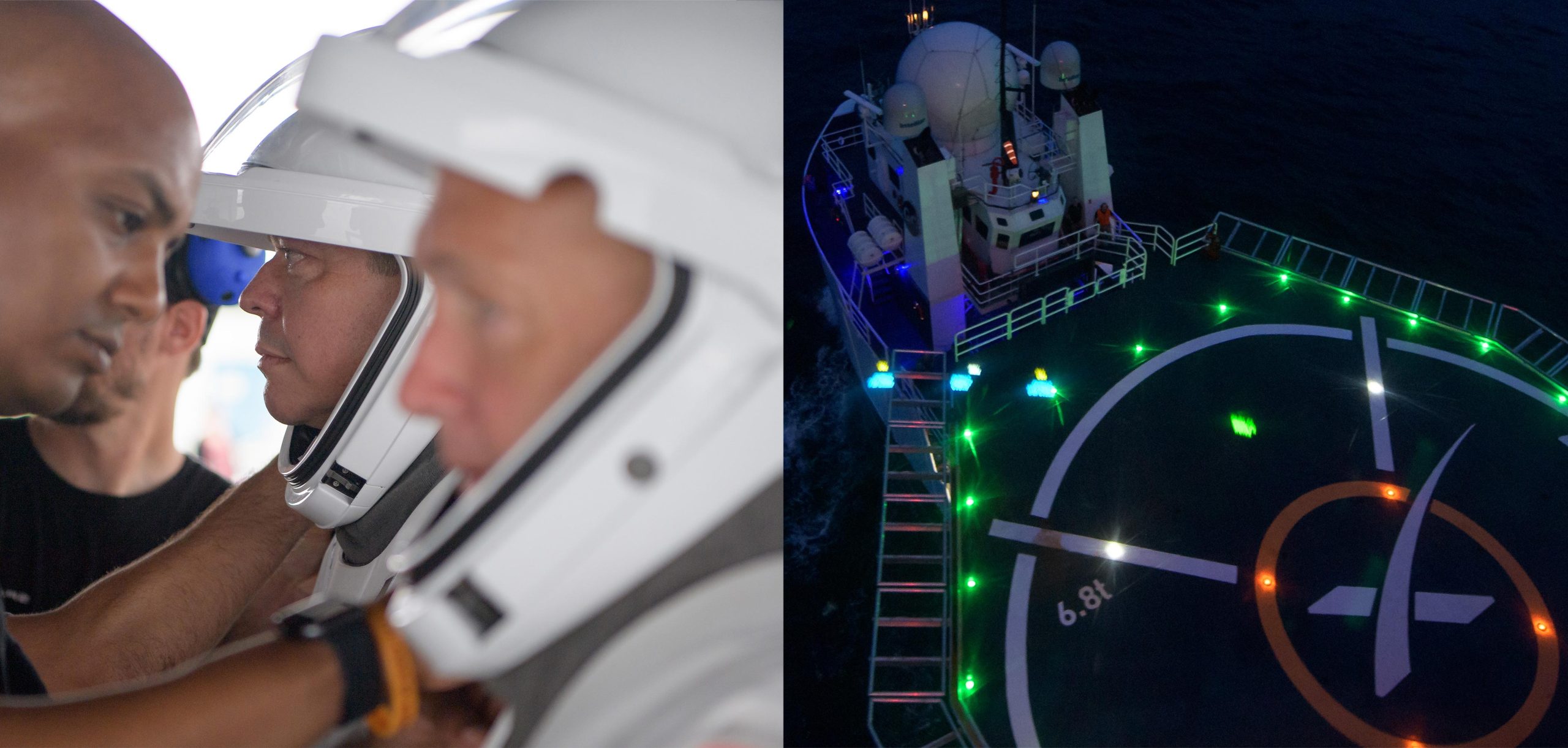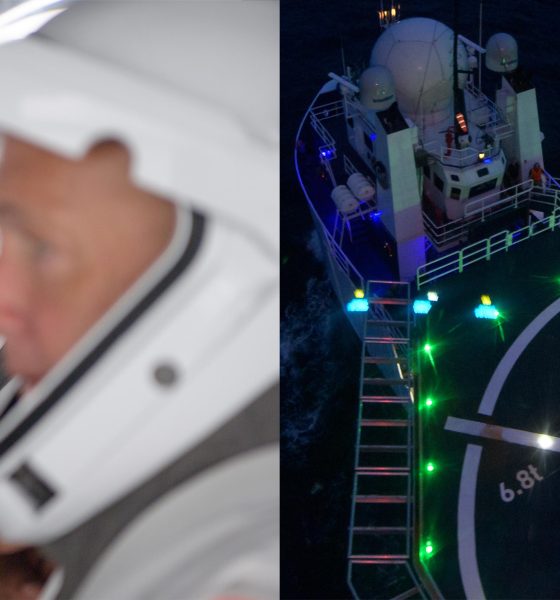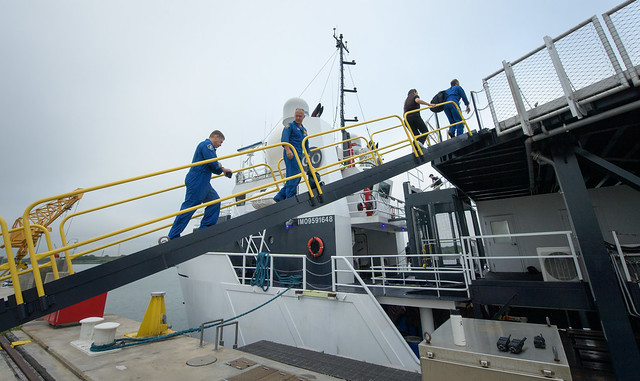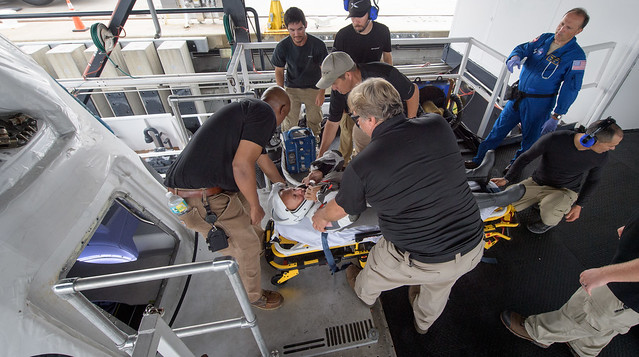

News
SpaceX, NASA practice astronaut recovery ahead of Crew Dragon’s crewed launch debut
SpaceX and NASA teams continue to prepare for Crew Dragon’s inaugural crewed launch (Demo-2) to the International Space Station (ISS) slated to possibly – but not likely – occur by year’s end.
On Tuesday, an official NASA Twitter account published images of teams from SpaceX and the space agency performing a full rehearsal of crew recovery and extraction procedures, including the duo of NASA astronauts scheduled to fly first on SpaceX’s next-generation spacecraft.
The rehearsal took place at the Trident Basin in Cape Canaveral, Florida aboard GO Searcher, one of two East Coast recovery vessels SpaceX uses for Crew Dragon recoveries.

A high-fidelity mockup of Crew Dragon was used to better familiarize all members involved with the process of safely extricating astronauts from the SpaceX spacecraft. This is the first time that multiple SpaceX and NASA teams have fully integrated to work aboard the ship and simulate the recovery process. The teams practiced helping the astronauts exit the capsule and simulated receiving medical attention that may be necessary when in a hypothetical emergency return from the ISS.

This practice run follows a recent full dress rehearsal of suit-up and pre-flight procedures that were conducted at SpaceX headquarters in Hawthorne, California. Following that dress rehearsal, SpaceflightNow.com reported that a newly installed slide wire emergency egress system was tested at Launch Pad 39A at Kennedy Space Center in Florida where the crewed DM-2 Mission will be launching from.
Crew Dragon’s Demonstration Mission 1 (Demo-1) launch presented SpaceX with a full-fidelity opportunity to hone capsule retrieval practices, but SpaceX teams did not practice astronaut extraction from the capsule – Demo-1 flight was uncrewed aside from an Anthropomorphic Test Device (i.e. dummy) nicknamed Ripley. The rehearsal on Tuesday served as familiarization for teams to extract astronauts from the capsule once it has been recovered aboard GO Searcher while still docked.
On Thursday, August 15th, two days after the above capsule extraction rehearsal, NASA once more posted photos of GO Searcher-related rehearsal operations, this time involving a drill in which astronauts needed to be airlifted immediately to land-based medical facilities. According to local observers and confirmed by the official NASA photos, a helicopter did indeed land on GO Searcher’s dedicated helipad before quickly departing with medically sensitive cargo. Searcher has its own simple medical facilities onboard but they are only capable of dealing with fairly routine concerns, focused primarily on aiding astronauts who are going from half a year in microgravity to full Earth gravity.
While there are still many milestones to get through before Crew Dragon can take flight for the second time, these numerous rehearsals of critical launch and recovery procedures are incredibly important, helping SpaceX and NASA teams hone their working relationship as both prepare to enter a new stage of the Commercial Crew Program. Demo-1 astronaut Col. Bob Behnken summarized it nicely, stating that, “each of these exercises puts us one step closer to fulfilling NASA’s mission of returning astronauts to the International Space Station from U.S. soil.”
Check out Teslarati’s Marketplace! We offer Tesla accessories, including for the Tesla Cybertruck and Tesla Model 3.

News
Tesla FSD fleet is nearing 7 billion total miles, including 2.5 billion city miles
As can be seen on Tesla’s official FSD webpage, vehicles equipped with the system have now navigated over 6.99 billion miles.

Tesla’s Full Self-Driving (Supervised) fleet is closing in on almost 7 billion total miles driven, as per data posted by the company on its official FSD webpage.
These figures hint at the massive scale of data fueling Tesla’s rapid FSD improvements, which have been quite notable as of late.
FSD mileage milestones
As can be seen on Tesla’s official FSD webpage, vehicles equipped with the system have now navigated over 6.99 billion miles. Tesla owner and avid FSD tester Whole Mars Catalog also shared a screenshot indicating that from the nearly 7 billion miles traveled by the FSD fleet, more than 2.5 billion miles were driven inside cities.
City miles are particularly valuable for complex urban scenarios like unprotected turns, pedestrian interactions, and traffic lights. This is also the difference-maker for FSD, as only complex solutions, such as Waymo’s self-driving taxis, operate similarly on inner-city streets. And even then, incidents such as the San Francisco blackouts have proven challenging for sensor-rich vehicles like Waymos.
Tesla’s data edge
Tesla has a number of advantages in the autonomous vehicle sector, one of which is the size of its fleet and the number of vehicles training FSD on real-world roads. Tesla’s nearly 7 billion FSD miles then allow the company to roll out updates that make its vehicles behave like they are being driven by experienced drivers, even if they are operating on their own.
So notable are Tesla’s improvements to FSD that NVIDIA Director of Robotics Jim Fan, after experiencing FSD v14, noted that the system is the first AI that passes what he described as a “Physical Turing Test.”
“Despite knowing exactly how robot learning works, I still find it magical watching the steering wheel turn by itself. First it feels surreal, next it becomes routine. Then, like the smartphone, taking it away actively hurts. This is how humanity gets rewired and glued to god-like technologies,” Fan wrote in a post on X.
News
Tesla starts showing how FSD will change lives in Europe
Local officials tested the system on narrow country roads and were impressed by FSD’s smooth, human-like driving, with some calling the service a game-changer for everyday life in areas that are far from urban centers.

Tesla has launched Europe’s first public shuttle service using Full Self-Driving (Supervised) in the rural Eifelkreis Bitburg-Prüm region of Germany, demonstrating how the technology can restore independence and mobility for people who struggle with limited transport options.
Local officials tested the system on narrow country roads and were impressed by FSD’s smooth, human-like driving, with some calling the service a game-changer for everyday life in areas that are far from urban centers.
Officials see real impact on rural residents
Arzfeld Mayor Johannes Kuhl and District Administrator Andreas Kruppert personally tested the Tesla shuttle service. This allowed them to see just how well FSD navigated winding lanes and rural roads confidently. Kruppert said, “Autonomous driving sounds like science fiction to many, but we simply see here that it works totally well in rural regions too.” Kuhl, for his part, also noted that FSD “feels like a very experienced driver.”
The pilot complements the area’s “Citizen Bus” program, which provides on-demand rides for elderly residents who can no longer drive themselves. Tesla Europe shared a video of a demonstration of the service, highlighting how FSD gives people their freedom back, even in places where public transport is not as prevalent.
What the Ministry for Economic Affairs and Transport says
Rhineland-Palatinate’s Minister Daniela Schmitt supported the project, praising the collaboration that made this “first of its kind in Europe” possible. As per the ministry, the rural rollout for the service shows FSD’s potential beyond major cities, and it delivers tangible benefits like grocery runs, doctor visits, and social connections for isolated residents.
“Reliable and flexible mobility is especially vital in rural areas. With the launch of a shuttle service using self-driving vehicles (FSD supervised) by Tesla in the Eifelkreis Bitburg-Prüm, an innovative pilot project is now getting underway that complements local community bus services. It is the first project of its kind in Europe.
“The result is a real gain for rural mobility: greater accessibility, more flexibility and tangible benefits for everyday life. A strong signal for innovation, cooperation and future-oriented mobility beyond urban centers,” the ministry wrote in a LinkedIn post.
News
Tesla China quietly posts Robotaxi-related job listing
Tesla China is currently seeking a Low Voltage Electrical Engineer to work on circuit board design for the company’s autonomous vehicles.

Tesla has posted a new job listing in Shanghai explicitly tied to its Robotaxi program, fueling speculation that the company is preparing to launch its dedicated autonomous ride-hailing service in China.
As noted in the listing, Tesla China is currently seeking a Low Voltage Electrical Engineer to work on circuit board design for the company’s autonomous vehicles.
Robotaxi-specific role
The listing, which was shared on social media platform X by industry watcher @tslaming, suggested that Tesla China is looking to fill the role urgently. The job listing itself specifically mentions that the person hired for the role will be working on the Low Voltage Hardware team, which would design the circuit boards that would serve as the nervous system of the Robotaxi.
Key tasks for the role, as indicated in the job listing, include collaboration with PCB layout, firmware, mechanical, program management, and validation teams, among other responsibilities. The role is based in Shanghai.
China Robotaxi launch
China represents a massive potential market for robotaxis, with its dense urban centers and supportive policies in select cities. Tesla has limited permission to roll out FSD in the country, though despite this, its vehicles have been hailed as among the best in the market when it comes to autonomous features. So far, at least, it appears that China supports Tesla’s FSD and Robotaxi rollout.
This was hinted at in November, when Tesla brought the Cybercab to the 8th China International Import Expo (CIIE) in Shanghai, marking the first time that the autonomous two-seater was brought to the Asia-Pacific region. The vehicle, despite not having a release date in China, received a significant amount of interest among the event’s attendees.








